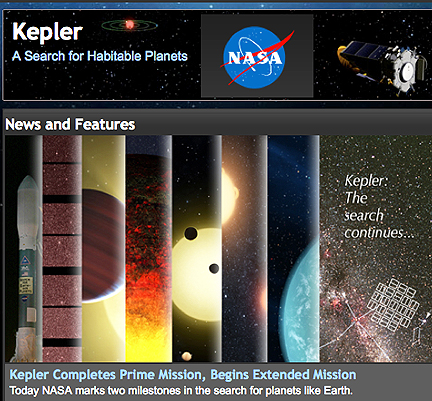...Kepler Space Telescope's 3-1/2 year prime mission and the start of an extended mission that could last as long as four years. Scientists have used Kepler data to identify more than 2,300 planet candidates and confirm more than 100 planets. Kepler is teaching us the galaxy is teeming with planetary systems and planets are prolific, and giving us hints that nature makes small planets efficiently.
So far, hundreds of Earth-size planet candidates have been found as well as candidates that orbit in the habitable zone, the region in a planetary system where liquid water might exist on the surface of a planet. None of the candidates is exactly like Earth. With the completion of the prime mission, Kepler now has collected enough data to begin finding true sun-Earth analogs—Earth-size planets with a one-year orbit around stars similar to the sun.
"The initial discoveries of the Kepler mission indicate at least a third of the stars have planets and the number of planets in our galaxy must number in the billions," said William Borucki, Kepler principal investigator at NASA's Ames Research Center in Moffett Field, Calif. "The planets of greatest interest are other Earths and these could already be in the data awaiting analysis. Kepler's most exciting results are yet to come."
 NASA's Kepler Space Telescope searches for planet candidates orbiting distant suns, or exoplanets, by continuously measuring the brightness of more than 150,000 stars. When a planet candidate passes, or transits, in front of the star from the spacecraft's vantage point, light from the star is blocked. Different sized planets block different amounts of starlight. The amount of starlight blocked by a planet reveals its size relative to its star. Kepler was launched March 6, 2009. Its mission was to survey a portion of the galaxy to determine what fraction of stars might harbor potentially habitable, Earth-sized planets. Planets orbiting in or near habitable zones are of particular interest.
NASA's Kepler Space Telescope searches for planet candidates orbiting distant suns, or exoplanets, by continuously measuring the brightness of more than 150,000 stars. When a planet candidate passes, or transits, in front of the star from the spacecraft's vantage point, light from the star is blocked. Different sized planets block different amounts of starlight. The amount of starlight blocked by a planet reveals its size relative to its star. Kepler was launched March 6, 2009. Its mission was to survey a portion of the galaxy to determine what fraction of stars might harbor potentially habitable, Earth-sized planets. Planets orbiting in or near habitable zones are of particular interest.
Kepler began the search for small worlds such as our own on May 12, 2009, after two months of commissioning. Within months, five exoplanets, known as hot Jupiters due to their enormous size and orbits close to their stars, were confirmed. In April 2012, NASA awarded Kepler an extended mission through as late as 2016. More time will enable the continued the search for worlds like our own—worlds that are not too far and too close to their sun.
Ames manages Kepler's ground system development, mission operations and science data analysis. NASA's Jet Propulsion Laboratory in Pasadena, Calif., managed the Kepler mission development. Ball Aerospace & Technologies Corp. in Boulder, Colo., developed the Kepler flight system and supports mission operations with the Laboratory for Atmospheric and Space Physics at the University of Colorado in Boulder. The Space Telescope Science Institute in Baltimore archives, hosts and distributes Kepler science data. Kepler is NASA's 10th Discovery Mission and funded by NASA's Science Mission Directorate at the agency's headquarters in Washington.

